
© L i s a t a T h e r a p e u t i c s , I n c . 2 0 2 4 . A l l r i g h t s r e s e r v e d . Targeted Therapy Delivered David J. Mazzo, Ph.D. President and Chief Executive Officer www.lisata.com Corporate Presentation | November 12, 2024 Nasdaq: LSTA Exhibit 99.2

2 Forward-looking statements advisory This presentation contains “forward-looking statements” that involve substantial risks and uncertainties for purposes of the safe harbor provided by the Private Securities Litigation Reform Act of 1995. All statements, other than statements of historical facts, included in this communication regarding strategy, future operations, future financial position, future revenue, projected expenses, prospects, plans and objectives of management are forward-looking statements. In addition, when or if used in this communication, the words “may,” “could,” “should,” “anticipate,” “believe,” “estimate,” “expect,” “intend,” “plan,” “predict”, “target” and similar expressions and their variants, as they relate to Lisata or its management, may identify forward-looking statements. Examples of forward-looking statements include, but are not limited to, statements relating to Lisata’s continued listing on the Nasdaq Capital Market; expectations regarding the capitalization, resources and ownership structure of Lisata; the approach Lisata is taking to discover, develop and commercialize novel therapeutics; the adequacy of Lisata’s capital to support its future operations and its ability to successfully initiate and complete clinical trials; and the difficulty in predicting the time and cost of development of Lisata’s product candidates. Actual results could differ materially from those contained in any forward-looking statement as a result of various factors, including, without limitation: the safety and efficacy of Lisata’s product candidates, decisions of regulatory authorities and the timing thereof, the duration and impact of regulatory delays in Lisata’s clinical programs, Lisata’s ability to finance its operations, the likelihood and timing of the receipt of future milestone and licensing fees, the future success of Lisata’s scientific studies, Lisata’s ability to successfully develop and commercialize drug candidates, the timing for starting and completing clinical trials, rapid technological change in Lisata’s markets, the ability of Lisata to protect its intellectual property rights and legislative, regulatory, political and economic developments. The foregoing review of important factors that could cause actual events to differ from expectations should not be construed as exhaustive and should be read in conjunction with statements that are included herein and elsewhere, including the risk factors included in Lisata’s Annual Report on Form 10-K filed with the SEC on February 29, 2024, and in other documents filed by Lisata with the Securities and Exchange Commission. Except as required by applicable law, Lisata undertakes no obligation to revise or update any forward-looking statement, or to make any other forward-looking statements, whether as a result of new information, future events or otherwise. Disclosure

Lisata at a Glance Company Overview 3

Lisata Therapeutics (Nasdaq: LSTA) Company Overview 4 WHAT WE ARE Clinical-stage therapeutics company rapidly developing a novel solid tumor targeting and penetration technology with tumor microenvironment (TME) modifying properties. OUR MISSION To enhance the treatment benefits of existing and emerging therapies for solid tumors and similar diseases without additional side effects utilizing an approach that is patient-friendly and pharmacoeconomically attractive.

Company Overview 5 Lisata Therapeutics (Nasdaq: LSTA): Key attributes Projected cash runway into early 2026, funding all current development programs through data Seasoned management with successful international drug development experience and expertise Platform technology validated by existing partnerships with potential for many others Multiple product and business milestones projected over the next 12 - 18 months Proprietary field- leading technology with global IP protection extending beyond 2040

Seasoned leadership with proven history of drug approvals worldwide 6 Kristen K. Buck, MD Executive Vice President of R&D and Chief Medical Officer Dr. Buck is a board certified and licensed physician with >20 years of strategic global drug development, drug/device safety/epidemiology, FDA, and clinical practice experience. Gregory Berkin Chief Information Officer and Data Protection Officer James Nisco SVP of Finance and Treasury and Chief Accounting Officer Tariq Imam VP of BD and Operations and Corporate Counsel John Menditto VP of Investor Relations and Corporate Communications Bill Sietsema, PhD VP of Global Regulatory Affairs Ryan Quick VP of Chemistry, Manufacturing and Controls Detailed bios can be found at www.lisata.com David J. Mazzo, PhD President and Chief Executive Officer, Member of the Board of Directors With >40 years of experience, Dr. Mazzo is a global pharmaceutical executive noted for his strategic prowess and his vast experience developing and launching new products across all therapeutical areas. He recently was recognized as a 2024 PharmaVoice Top 100 Standout Leader. Company Overview

Therapeutic Focus and Rationale 7

Improved solid tumor treatment remains a vital, growing global need Globally in 2022(2),(3) 20 million new cancer cases 10 million deaths >90% solid tumors 35 million new cancer cases 18.5 million deaths >90% solid tumors +77% Examples of solid tumors: Lung, breast, pancreas, liver, bile duct (cholangiocarcinoma), kidneys, ovaries, brain, colon, prostate, esophagus, and head & neck. Over the next 30 years, cancer will cost the world $25 trillion(1) 1 Cancer will cost the world $25 trillion over next 30 years (nature.com) 2 https://gco.iarc.who.int/tomorrow/en/dataviz/tables?mode=population&years=2050&types=1&populations=903_904_905_908_909_935_900; data retrieved Feb 12, 2024. 3 https://seer.cancer.gov/statfacts/html/common.html; data retrieved Nov 2, 2023. 4 https://www.who.int/news/item/01-02-2024-global-cancer-burden-growing--amidst-mounting-need-for-services; data retrieved Oct 14, 2024. 5 Europe Is Facing a Pancreatic Cancer Emergency - Medscape - January 25, 2024. Therapeutic Focus and Rationale 8 Globally in 2050(4) Pancreatic Cancer Stats By 2030, PDAC* is predicted to be the second most common cause of cancer mortality(5) Today, only 3% of PDAC patients survive for 5 years, with life expectancy at diagnosis of just 4.6 months *Pancreatic ductal adenocarcinoma (PDAC)
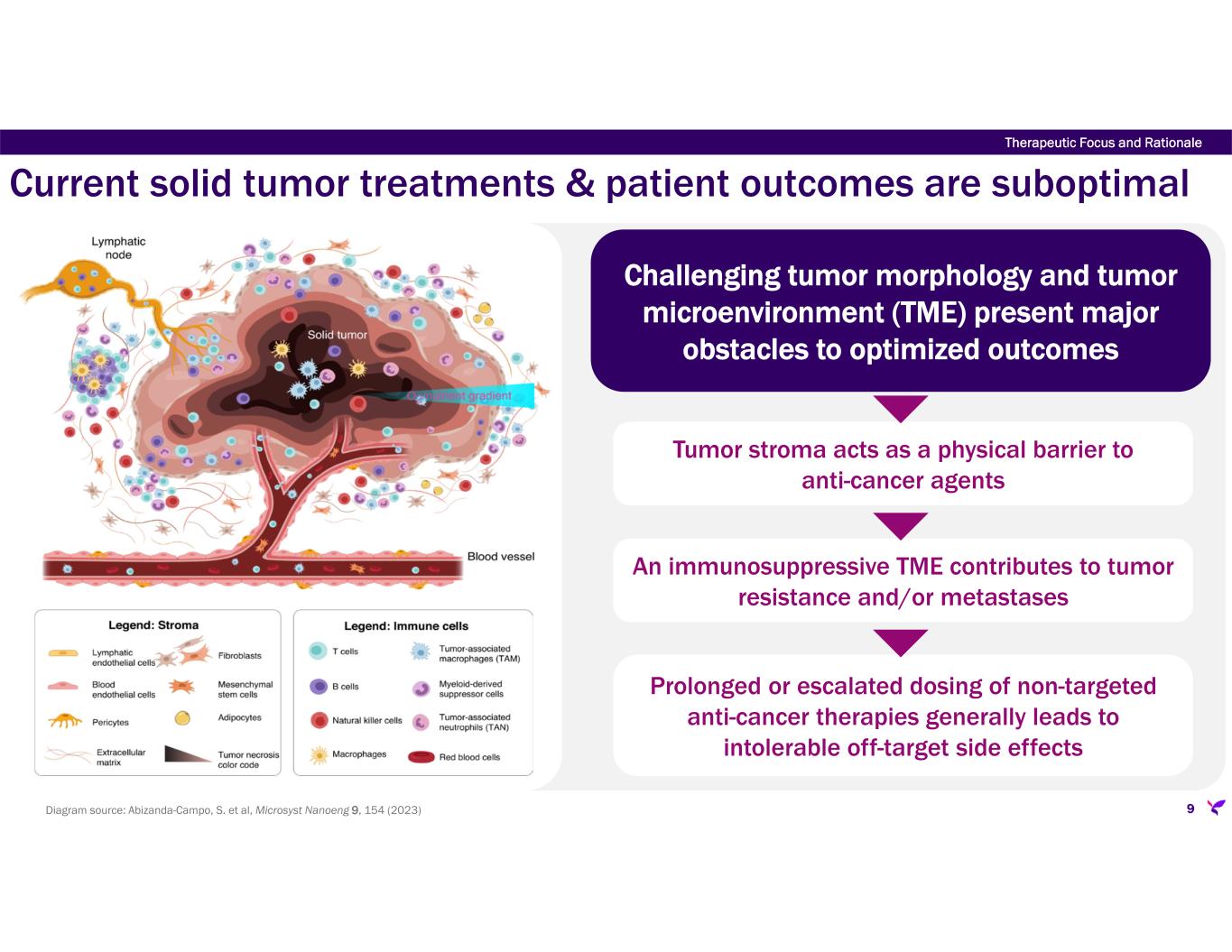
Current solid tumor treatments & patient outcomes are suboptimal Challenging tumor morphology and tumor microenvironment (TME) present major obstacles to optimized outcomes Tumor stroma acts as a physical barrier to anti-cancer agents An immunosuppressive TME contributes to tumor resistance and/or metastases Prolonged or escalated dosing of non-targeted anti-cancer therapies generally leads to intolerable off-target side effects 9 Therapeutic Focus and Rationale Diagram source: Abizanda-Campo, S. et al, Microsyst Nanoeng 9, 154 (2023)

Certepetide designed to optimize solid tumor treatment outcomes Dense stromal barrier physically inhibiting drug entry Employ internalizing RGD* (iRGD) peptide to target tumor and trigger CendR active transport CHALLENGE APPROACH Immunosuppressive TME which impedes the immune system Employ specific iRGD that reduces immunosuppressive T cells and recruits cytotoxic T cells Frequent metastases Employ specific iRGD that inhibits the metastatic cascade SOLUTION: Certepetide In late-stage clinical development in several solid tumors based on strong preclinical and early clinical evidence Converts tumor stroma from a barrier to a conduit for anti-cancer drugs Selectively reduces immunosuppressive T cells and increases cytotoxic T cells(1) Inhibits the metastatic cascade(2) Agnostic to the anti-cancer modality with which it is applied; can be co-administered or molecularly bound (tethered) 10 Therapeutic Focus and Rationale 1 Sugahara, et al. Mol Cancer Ther; 14(1) January 2015; Hamilton, et al., J MolMed. April 2015; and Miyamura, et al., bioRxiv. May 2023. 2 Yuan, D., Duda, D., et al. CCA Foundation Conf. 2024 Poster. Enhancing the efficacy of standard therapy in intrahepatic cholangiocarcinoma using LSTA1, a novel tumor targeting and penetration agent *internalizing Arginylglycylaspartic acid (iRGD)

Partnerships Noteworthy existing relationships and potential for many more 11

Existing partnerships support certepetide’s promise & broad applicability Strategic commercial partnership in China with Qilu Pharmaceutical Qilu granted exclusive rights in China, Taiwan, Hong Kong and Macau Qilu assumes all development and commercialization responsibilities/costs in licensed territories Lisata collected $15 million in milestones to date Potential for additional $221 million in milestones plus royalties on sales to Lisata R&D alliances contribute resources with little to no commercial interest in certepetide Australasian Gastro-Intestinal Trials Group - Clinical Trialists Consortium (Australia & New Zealand) WARPNINE - Foundation (Australia) Additional partnership opportunities exist for many combinations with certepetide By indication, modality of co-administered drug(s), and/or geography Partnerships 12

13 Certepetide Strong Scientific Foundation and Rationale
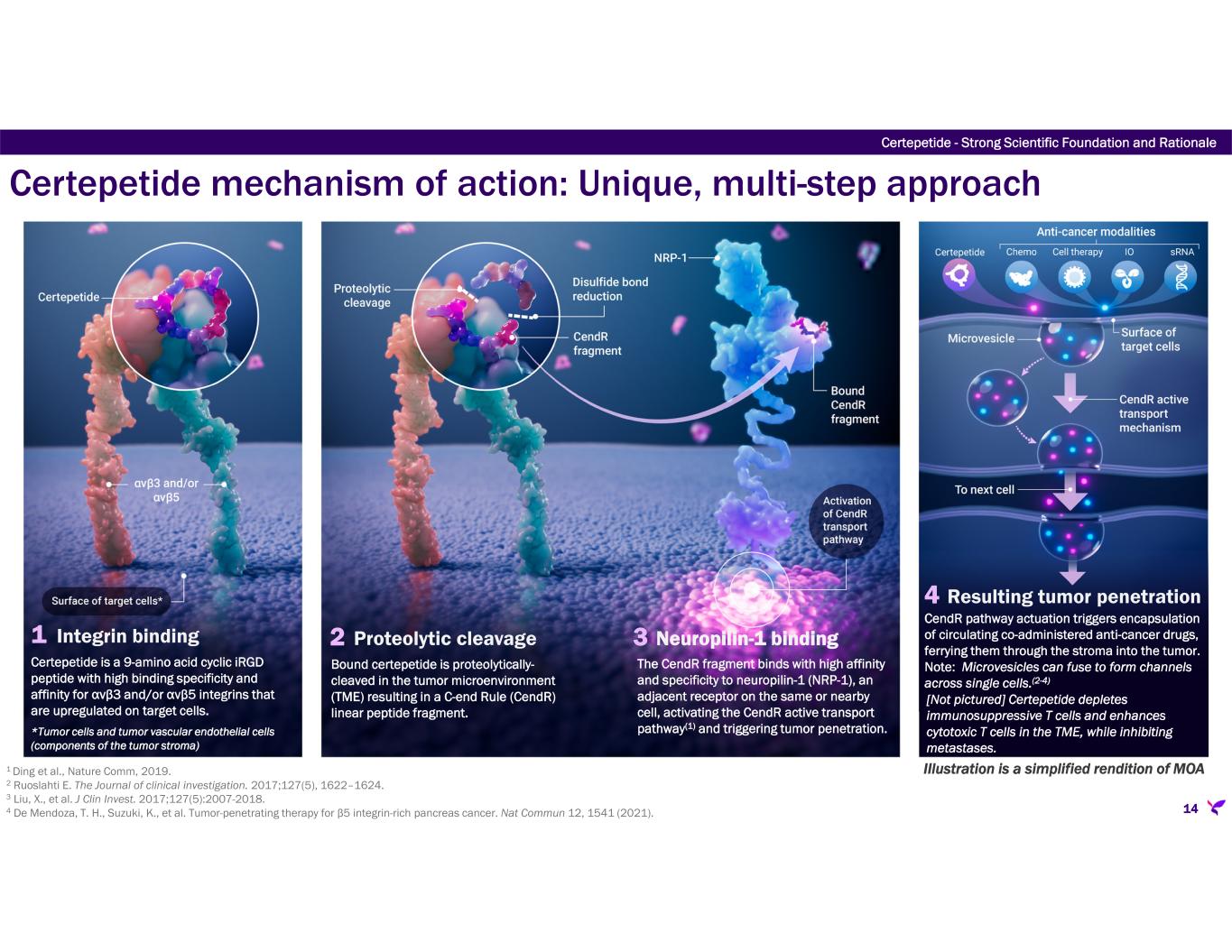
Certepetide mechanism of action: Unique, multi-step approach Certepetide - Strong Scientific Foundation and Rationale 14 1 Integrin binding 2 Proteolytic cleavage 3 Neuropilin-1 binding 4 Resulting tumor penetration Bound certepetide is proteolytically- cleaved in the tumor microenvironment (TME) resulting in a C-end Rule (CendR) linear peptide fragment. The CendR fragment binds with high affinity and specificity to neuropilin-1 (NRP-1), an adjacent receptor on the same or nearby cell, activating the CendR active transport pathway(1) and triggering tumor penetration. Certepetide is a 9-amino acid cyclic iRGD peptide with high binding specificity and affinity for αvβ3 and/or αvβ5 integrins that are upregulated on target cells. *Tumor cells and tumor vascular endothelial cells (components of the tumor stroma) CendR pathway actuation triggers encapsulation of circulating co-administered anti-cancer drugs, ferrying them through the stroma into the tumor. Note: Microvesicles can fuse to form channels across single cells.(2-4) [Not pictured] Certepetide depletes immunosuppressive T cells and enhances cytotoxic T cells in the TME, while inhibiting metastases. Illustration is a simplified rendition of MOA 1 Ding et al., Nature Comm, 2019. 2 Ruoslahti E. The Journal of clinical investigation. 2017;127(5), 1622–1624. 3 Liu, X., et al. J Clin Invest. 2017;127(5):2007-2018. 4 De Mendoza, T. H., Suzuki, K., et al. Tumor-penetrating therapy for β5 integrin-rich pancreas cancer. Nat Commun 12, 1541 (2021).

Certepetide/iRGD selectively promotes intratumoral penetration 1 Braun et al., Nature Mater. 2014. 2 Liu, Braun et al., Nature Comm. 2017. 3 Sugahara et al 2010. 15 Certepetide - Strong Scientific Foundation and Rationale Whole body imaging of mice with pancreatic ductal adenocarcinoma (arrow) dosed with Fluorescent Quantum Dots (FQDs) with and without certepetide(1),(2) Circulating FQDs result in whole body fluorescence Etching solution quenches fluorescence in circulation tumor FQDs + Etching solution tumor g Certepetide + FQDs + Etchin solution In the presence of iRGD, Abraxane (ABX) is selectively taken up by tumor tissue in mice(3) Certepetide is a proprietary iRGD; experiments denoting iRGD use a non-proprietary certepetide analog with differs in structure by a single acetyl group. FQDs

Broad applicability & activity of certepetide/iRGD consistently demonstrated Sampling of >350 scientific publications showing improved survival 16 Breast cancer + Herceptin®Lung cancer + gemcitabine Zhang, et al., Plos One, 2015 Breast cancer + nanoparticle nab-paclitaxel GI cancer + adoptive cell therapy Ding, et al., Nature, 2019 PDAC + irinotecan nanoparticles Orthotopically transplanted KPC PDAC tumors iRGD + irinotecan nanoparticles (i.v. co-admin) Liu X et al., J Clin Invest, 2017 PDAC + gemcitabine KPC mice genetically engineered to develop PDAC iRGD + gemcitabine (i.v. co-admin) Hurtado de Mendoza et al, Nature Comms, 2021 Sugahara, et al., Science, 2010Sugahara, et al., Science, 2010 Certepetide - Strong Scientific Foundation and Rationale Certepetide is a proprietary iRGD; experiments denoting iRGD use a non-proprietary certepetide analog with differs in structure by a single acetyl group.

Certepetide/iRGD consistently improves immunotherapy efficacy in multiple preclinical solid tumor models 17 Certepetide/iRGD vs. Control GroupStudy Description → Significantly improved overall survival → Significantly reduced tumor volume → Significantly reduced metastases Intrahepatic cholangiocarcinoma (ICC) murine model Certepetide + anti-PD-1 + cytotoxics vs. controls Pancreatic adenocarcinoma (PDAC) murine model Certepetide + anti-PD-L1 + cytotoxics vs. controls → Significantly reduced tumor size Prostate cancer murine model iRGD vs. scrambled iRGDD control Breast cancer (human BT474) murine model Trastuzumab + iRGD vs. trastuzumab control Non-Small Cell Lung Cancer (NSCLC) murine model Cetuximab + iRGD vs. cetuximab and iRGD control → Significantly increased NKT cell penetration → Significantly reduced tumor size Gastric cancer HGC27 tumor spheroids iRGD + natural killer T cells (NKT cells vs. NKT cells alone) Hepatocellular carcinoma (HCC) murine model iRGD + NKT cells vs. NKT cells alone Certepetide - Strong Scientific Foundation and Rationale Certepetide is a proprietary iRGD; experiments denoting iRGD use a non-proprietary certepetide analog with differs in structure by a single acetyl group.

Certepetide improves immunotherapy impact in cholangiocarcinoma 18 Certepetide - Strong Scientific Foundation and Rationale Intrahepatic cholangiocarcinoma (ICC) has an immunosuppressive TME and a dense desmoplastic stroma with abnormal vasculature which together impede anti-cancer agent efficacy Lung metastases often lead to a significant decline in survival Human ICC SoC (gemcitabine/cisplatin/durvalumab) efficacy improved with certepetide in murine model Yuan, D., Duda, D., et al. CCA Foundation Conf. (2024) Poster. Enhancing the efficacy of standard therapy in intrahepatic cholangiocarcinoma using LSTA1, a novel tumor targeting and penetration agent Certepetide combined with chemo- and immunotherapy improves survival, reduces morbidity and inhibits metastasis in cholangiocarcinoma mouse model ICC mouse model *Certepetide was formerly known as LSTA1

iRGD enhances selective tumor penetration of trastuzumab Mouse model injected with human BT474 breast tumors Panel A shows greater staining for trastuzumab in breast cancer tissue with iRGD Panel B shows remarkable selectivity for tumor tissue with iRGD Panel C shows iRGD co-administered with trastuzumab leads to tumor shrinkage Sugahara, et al. 2010 Certepetide - Strong Scientific Foundation and Rationale 19 Trastuzumab + iRGDTrastuzumab A CB Tumor Liver Spleen HeartPancreas Lung Kidney Brain Certepetide is a proprietary iRGD; experiments denoting iRGD use a non-proprietary certepetide analog with differs in structure by a single acetyl group. Trastuzumab is a monoclonal Ab that inhibits HER2

Certepetide development strategy is composed of two main pillars 20 Pursue rapid global registration in pancreatic ductal adenocarcinoma (mPDAC), initially combined with gemcitabine/nab-paclitaxel standard-of-care (SoC) Phase 2b 100% enrolled Phase 3 preparation underway Demonstrate certepetide effectiveness when combined with a variety of other SoC regimens (e.g., chemotherapy, immunotherapy, etc.) in a variety of solid tumors Multiple Phase 1b/2a studies underway Certepetide - Strong Scientific Foundation and Rationale

1 Von Hoff D, et al., New England Journal of Medicine, 2013. 2 Dean A, et al., The Lancet Gastroenterology & Hepatology, 2022 3 QILU Pharmaceutical 21 Certepetide - Strong Scientific Foundation and Rationale Certepetide improved survival in metastatic pancreatic cancer in two independent multicenter, Phase 1b/2a studies 5.5 months 9.7 months SoC 0.5 2.5 4.5 6.5 8.5 10.5 12.5 Median Overall Survival (Months) M on th s Gemcitabine + Nab-paclitaxel Gemcitabine + Nab-paclitaxel + certepetide Gemcitabine + Nab-paclitaxel + certepetide CEND1-001 Australia Phase 1b/2a 13.2 months 8.5 months 1 2 11.1 months 3 55% improvement in median OS with addition of certepetide Von Hoff 2013* CEND1-002 China Phase 1b/2a SoC + certepetide 31% improvement in median OS with addition of certepetide SoC *Seminal study for establishing gemcitabine/nab-paclitaxel as mPDAC SoC

1 Von Hoff D, et al., New England Journal of Medicine, 2013. 2 Dean A, et al., The Lancet Gastroenterology & Hepatology, 2022 3 QILU Pharmaceutical 22 Certepetide demonstrated internal consistency of response in two Phase 1b/2a studies Complete Response Partial Response Objective Response Rate Disease Control Rate at 16 weeks CA19-9 Drop >20% Median PFS Gemcitabine + Nab-paclitaxel Gemcitabine + Nab-paclitaxel + certepetide Gemcitabine + Nab-paclitaxel + cerptepetide 42% 23%1 Von Hoff 2013* SoC + certepetide 59% 23% 3.4% 0.1% 55% 79% 96% 2 0 42% 48% 61% 87% 91% 3 CEND1-001 Australia Phase 1b/2a CEND1-201 China Phase 1b/2a SoC SoC SoC SoCSoC 5.5 mo 9.7 mo 5.8 mo Certepetide - Strong Scientific Foundation and Rationale 1 *Seminal study for establishing gemcitabine/nab-paclitaxel as mPDAC SoC
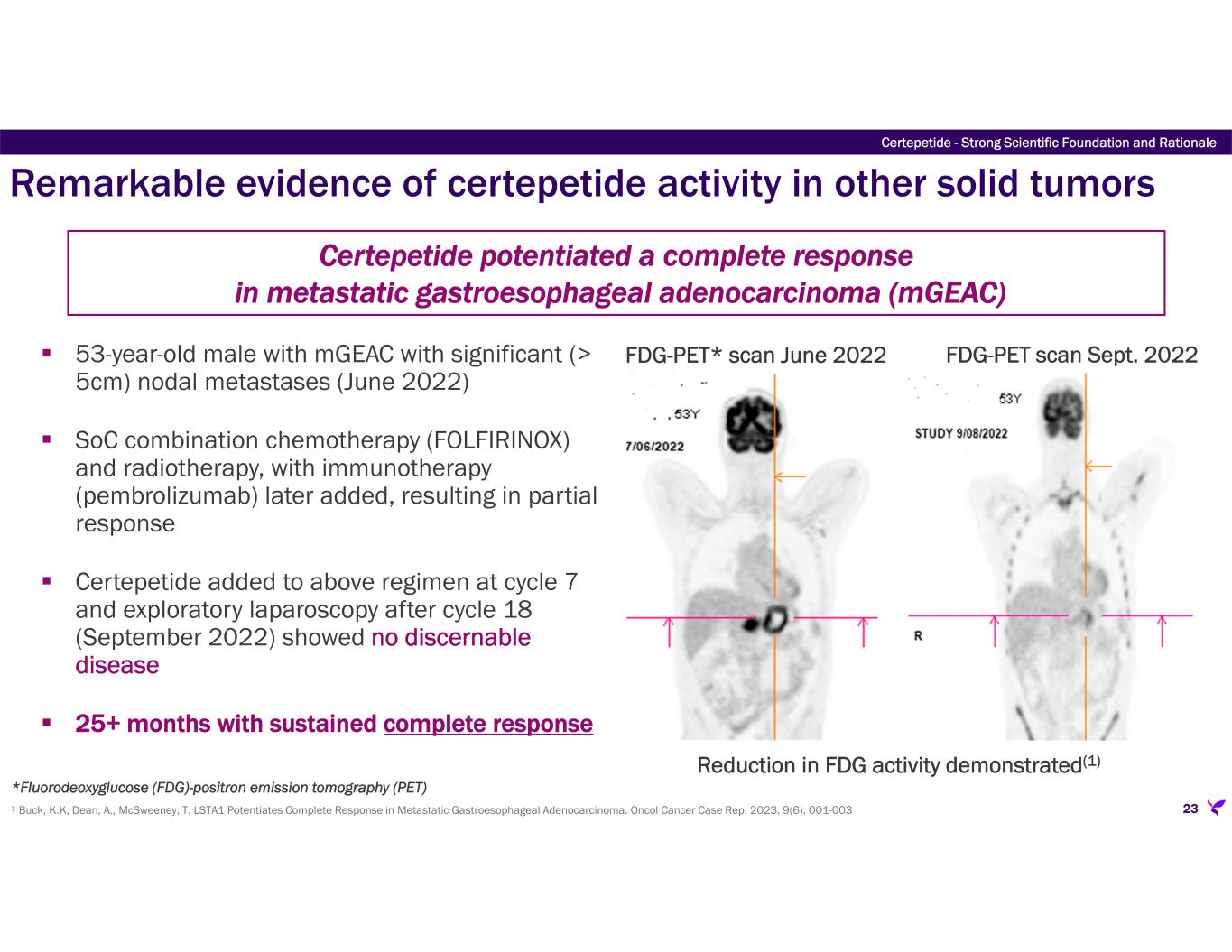
Remarkable evidence of certepetide activity in other solid tumors Certepetide potentiated a complete response in metastatic gastroesophageal adenocarcinoma (mGEAC) FDG-PET* scan June 2022 FDG-PET scan Sept. 2022 Reduction in FDG activity demonstrated(1) 53-year-old male with mGEAC with significant (> 5cm) nodal metastases (June 2022) SoC combination chemotherapy (FOLFIRINOX) and radiotherapy, with immunotherapy (pembrolizumab) later added, resulting in partial response Certepetide added to above regimen at cycle 7 and exploratory laparoscopy after cycle 18 (September 2022) showed no discernable disease 25+ months with sustained complete response 231 Buck, K.K, Dean, A., McSweeney, T. LSTA1 Potentiates Complete Response in Metastatic Gastroesophageal Adenocarcinoma. Oncol Cancer Case Rep. 2023, 9(6), 001-003 Certepetide - Strong Scientific Foundation and Rationale *Fluorodeoxyglucose (FDG)-positron emission tomography (PET)

Accumulating clinical data demonstrate certepetide’s ability to augment anti-cancer efficacy of chemotherapy alone and with immunotherapy 24 Certepetide - Strong Scientific Foundation and Rationale Certepetide Clinical Data Summary to Date Two Phase 1b/2a clinical trials (CEND1-001 – Australia and CEND1-201 - China) demonstrate that certepetide plus chemotherapy SoC improves overall survival in metastatic PDAC Well-tolerated with no dose-limiting toxicity; AEs similar to companion therapy alone Sustained complete response in patient with metastatic gastroesophageal cancer Phase 1b/2a trial (iLSTA): randomized, patient-blinded interim data demonstrate: • Certepetide plus chemotherapy SoC and immunotherapy improves clinical outcomes in locally advanced PDAC

25 Certepetide Clinical/Regulatory Development Portfolio

Certepetide – Clinical / Regulatory Development Portfolio Certepetide special regulatory designations and benefits 26 FDA Fast Track Designation • Pancreatic cancer (FDA) Eligible for Accelerated Approval, Priority Review and Rolling Review Provides for program-specific guidance from and frequent communication with FDA Orphan Drug Designations • Pancreatic cancer (FDA & EMA) • Malignant glioma (FDA) • Osteosarcoma (FDA) • Cholangiocarcinoma (FDA) Eligible for tax credits, marketing exclusivity, fee waivers and development grants Provides for specialized regulatory assistance from FDA's Office of Orphan Products Development FDA Rare Pediatric Disease Designation • Osteosarcoma (FDA) Eligible for Priority Review Voucher upon approval; redeemable for a priority review for any subsequent marketing application, or may be sold or transferred Vouchers have sold recently for $75-$100 million and, historically, for up to $350 million

Certepetide capital efficient clinical development plan Current Phase DescriptionIndicationSponsor(s) Phase 3Phase 2Phase 1 ASCEND: Phase 2b, placebo-controlled trial (N=158) Gemcitabine/nab-paclitaxel + certepetide or placebo Australia/New Zealand First-line mPDACAGITG/Lisata BOLSTER: Phase 2a, placebo-controlled trial (N=80) 1L CCA: Gemcitabine/cisplatin/durvalumab with certepetide or placebo 2L CCA: FOLFOX with certepetide or placebo United States First- and Second-line Cholangiocarcinoma (CCA)Lisata CENDIFOX: Phase 1b/2a, open-label trial (N=51) FOLFIRINOX + panitumumab* + certepetide United States Pancreatic, Colon, and Appendiceal Cancers KUCC/Lisata Investigator-initiated trial Phase 1b/2a, open-label trial (N=41) Gemcitabine/nab-paclitaxel + certepetide China First-line mPDACQilu/Lisata iLSTA: Phase 1b/2a, open-label trial (N=30) Gemcitabine/nab-paclitaxel/durvalumab + certepetide Australia Locally advanced, non- resectable PDACWARPNINE/Lisata Phase 2a, placebo-controlled trial (N=30) Temozolomide +/- certepetide Estonia/Latvia First-line Glioblastoma Multiforme (GBM) Tartu University/Lisata Investigator-initiated trial Phase 2, placebo-controlled trial (N=120) Gemcitabine/nab-paclitaxel + certepetide China First-line mPDACQilu/Lisata FORTIFIDE: Phase 1b/2a placebo-controlled trial (N=30) Gemcitabine/nab-paclitaxel + continuous infusion of certepetide/placebo United States Second-line mPDACLisata Enrollment complete Enrolling Enrollment complete Enrolling *Panitumumab may be added for colorectal or appendiceal patients without Ras mutation. Certepetide – Clinical / Regulatory Development Portfolio 27 Enrolling Enrolling 1L CCA Enrollment complete 2L CCA Enrolling Enrolling soon

Certepetide preclinical activities and milestones Upcoming MilestonesObjective and DescriptionIndicationSponsor(s) Target date for data: 1Q2025 Assess the therapeutic effect of adding certepetide to bevacizumab (VEGF inhibitor) on the size and number of endometriotic lesions. Certepetide + bevacizumab Murine endometriosis model C57BL/6J United States EndometriosisUniversity of Cincinnati/Lisata Target date for data: 2Q2025 Assess the therapeutic effects of PeptiCRAd (oncolytic virus), certepetide, and a checkpoint inhibitor (CPI) on systemic T cell responses, T cell infiltration into tumors, and impact on tumor growth control. Certepetide + PeptiCRAd + CPI Murine melanoma model B16-OVA Finland MelanomaValo Therapeutics/Lisata Certepetide – Clinical / Regulatory Development Portfolio 28

Clinical Development Milestones 29

A wealth of anticipated key certepetide clinical milestones 30 1Q 20264Q 20253Q 20252Q 20251Q 20254Q 20243Q 20242Q 20241Q 20244Q 20233Q 20232Q 2023 ASCEND [AUS, NZ] First-line mPDAC BOLSTER [USA] First- and second-line CCA CENDIFOX [USA] Pancreatic, Colon and Appendiceal Cancers Qilu: Phase 1b/2a [CHN] First-line mPDAC iLSTA [AUS] Non-resectable mPDAC Phase 2a [EST, LATV] First-line GBM Qilu: Phase 2 [CHN] First-line mPDAC FORTIFIDE [USA] Second-line mPDAC Development Milestones PDAC cohort Colon/Appendiceal cohortsEnrolling Final 6-month PFS/OS data Enrolling Cohort A top-line data Final Cohort A & B PFS/OS data Futility analysisEnrolling Preliminary PFS data Final data ORR dataEnrolling *Several of these studies are investigator-initiated trials. Lisata has limited control and thus, timelines and expectations may be subject to change. PFS: Progression-free Survival OS: Overall Survival ORR: Objective Response Rate First patient in Last patient in Interim analysis Data Final data Milestone achievedSafety run-in analysis Enrolling Safety run-in analysis 1L & 2L OS data1L CCA FPI 1L CCA LPI Achieved 6 months early 2L CCA LPI2L CCA FPI Biomarker Data Final PFS/OS data

Financial Highlights 31
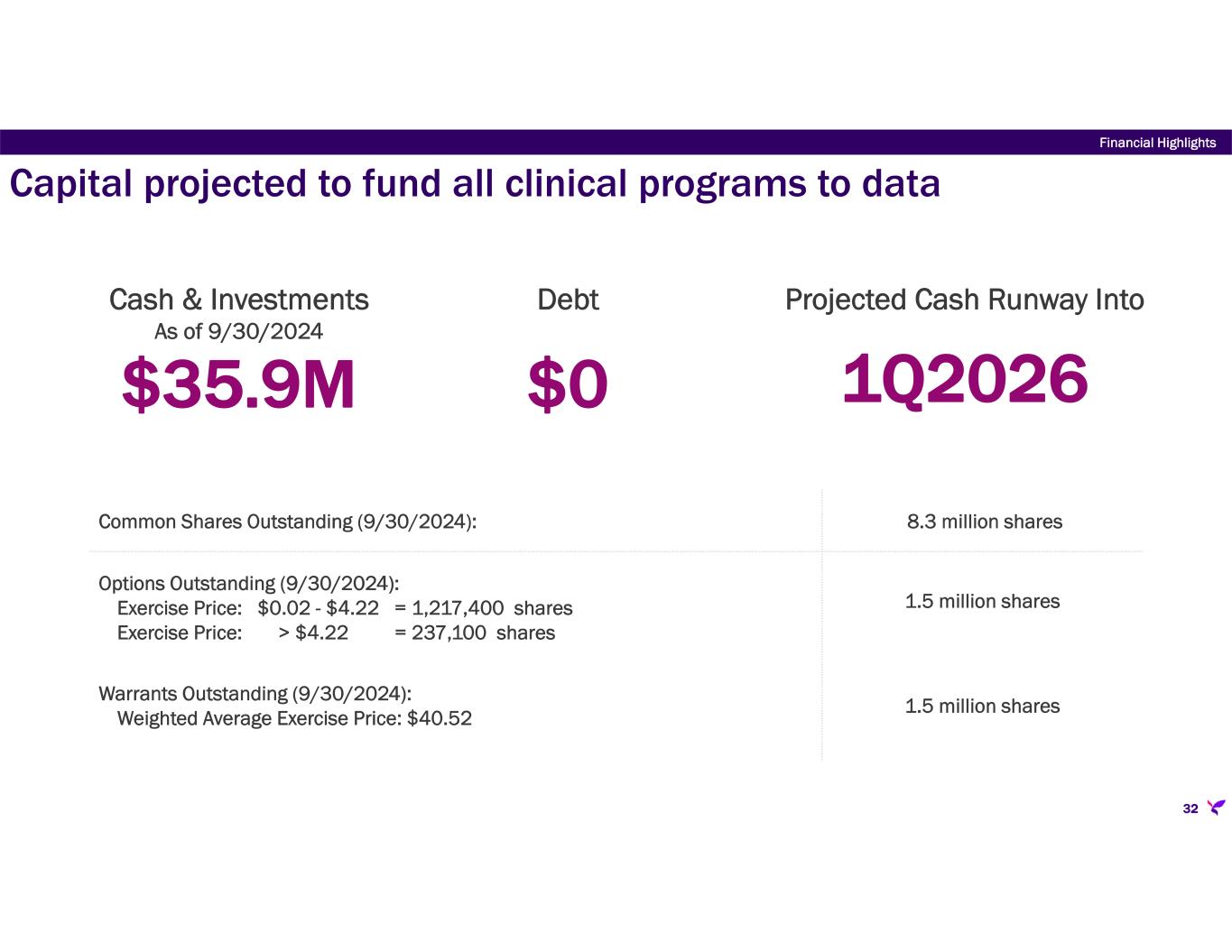
Capital projected to fund all clinical programs to data Financial Highlights 32 $35.9M Cash & Investments As of 9/30/2024 $0 Debt 1Q2026 Projected Cash Runway Into 8.3 million sharesCommon Shares Outstanding (9/30/2024): 1.5 million shares Options Outstanding (9/30/2024): Exercise Price: $0.02 - $4.22 = 1,217,400 shares Exercise Price: > $4.22 = 237,100 shares 1.5 million shares Warrants Outstanding (9/30/2024): Weighted Average Exercise Price: $40.52

Investment Thesis Promising asset based on a body of compelling data Rational and focused development portfolio Highly experienced management team Financially stable company 33

* As of 9/30/2024; includes investments Key factors supporting investment in Lisata Therapeutics 34 Strong Investment Rationale PEOPLE Seasoned management with successful international drug development experience and expertise INTELLECTUAL PROPERTY Proprietary field- leading technology with global IP protection extending beyond 2040 MILESTONES Multiple product and business milestones projected over the next 12 - 18 months CAPITAL $35.9 million cash*- no debt; Current development funded through critical data milestones PARTNERING Platform technology validated by existing partnerships with potential for many others

© L i s a t a T h e r a p e u t i c s , I n c . 2 0 2 4 . A l l r i g h t s r e s e r v e d . Investor Relations Contact: John D. Menditto VP, IR & Corporate Communications Tel: (908) 842-0084 | Email: jmenditto@lisata.com Nasdaq: LSTA | www.lisata.com Targeted Therapy Delivered
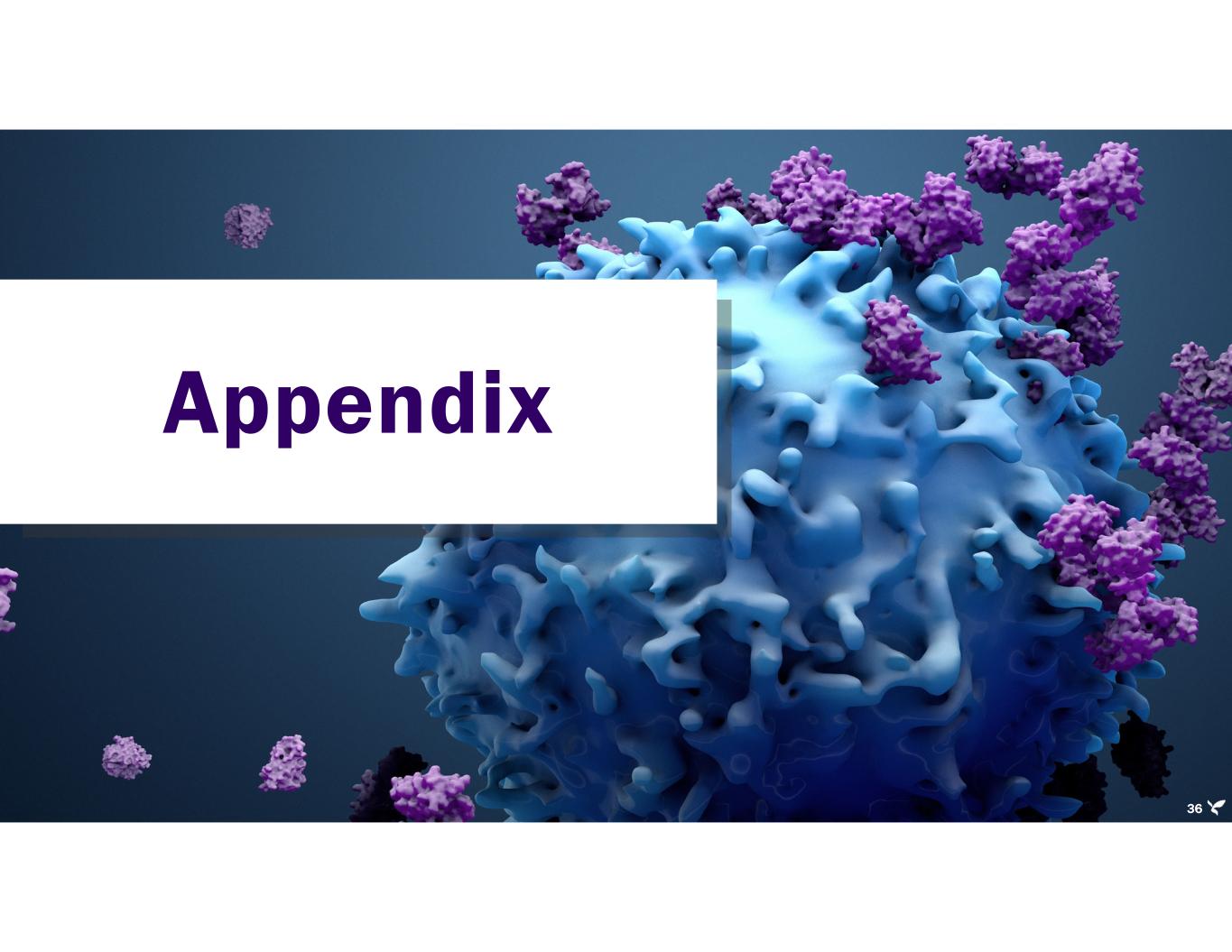
Appendix 36
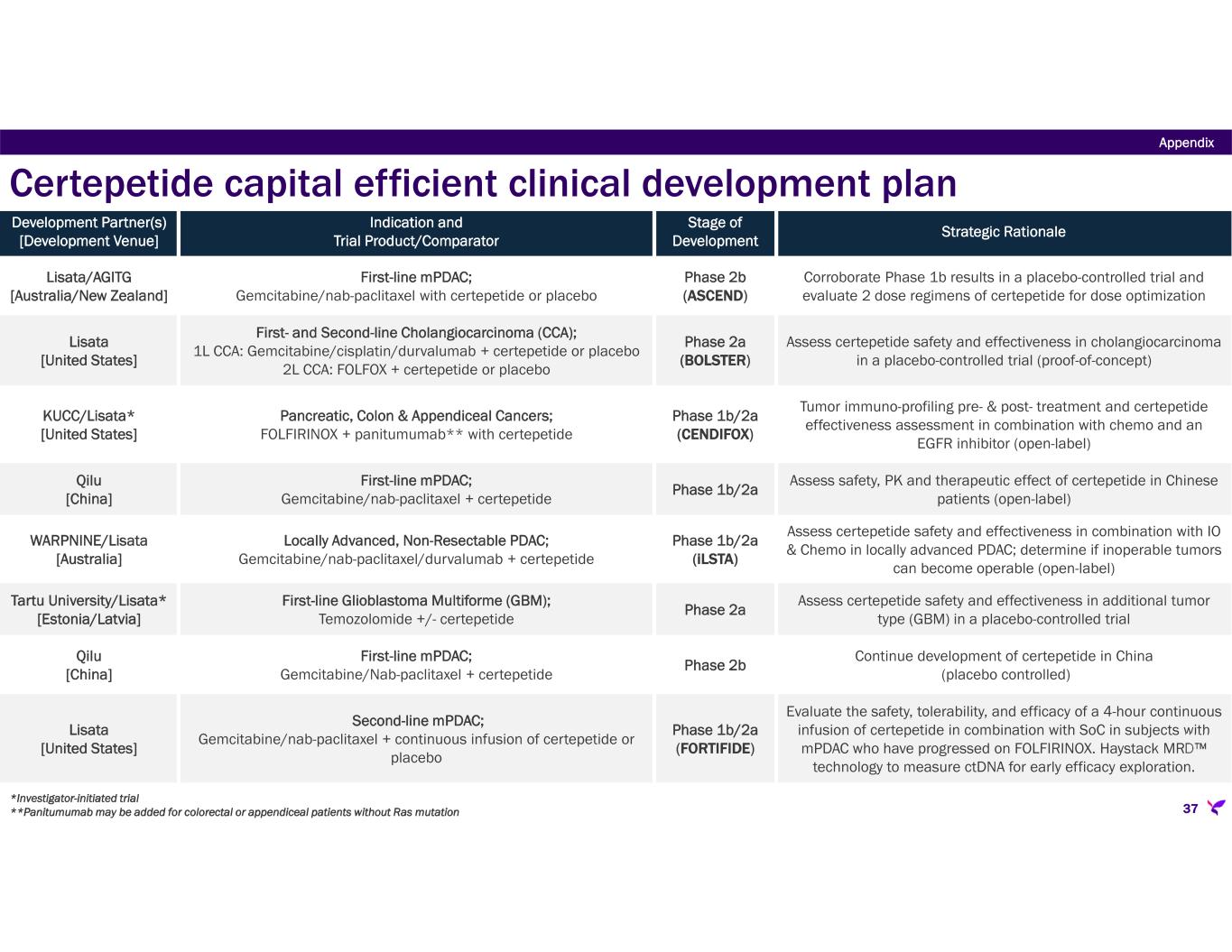
Strategic Rationale Stage of Development Indication and Trial Product/Comparator Development Partner(s) [Development Venue] Corroborate Phase 1b results in a placebo-controlled trial and evaluate 2 dose regimens of certepetide for dose optimization Phase 2b (ASCEND) First-line mPDAC; Gemcitabine/nab-paclitaxel with certepetide or placebo Lisata/AGITG [Australia/New Zealand] Assess certepetide safety and effectiveness in cholangiocarcinoma in a placebo-controlled trial (proof-of-concept) Phase 2a (BOLSTER) First- and Second-line Cholangiocarcinoma (CCA); 1L CCA: Gemcitabine/cisplatin/durvalumab + certepetide or placebo 2L CCA: FOLFOX + certepetide or placebo Lisata [United States] Tumor immuno-profiling pre- & post- treatment and certepetide effectiveness assessment in combination with chemo and an EGFR inhibitor (open-label) Phase 1b/2a (CENDIFOX) Pancreatic, Colon & Appendiceal Cancers; FOLFIRINOX + panitumumab** with certepetide KUCC/Lisata* [United States] Assess safety, PK and therapeutic effect of certepetide in Chinese patients (open-label) Phase 1b/2a First-line mPDAC; Gemcitabine/nab-paclitaxel + certepetide Qilu [China] Assess certepetide safety and effectiveness in combination with IO & Chemo in locally advanced PDAC; determine if inoperable tumors can become operable (open-label) Phase 1b/2a (iLSTA) Locally Advanced, Non-Resectable PDAC; Gemcitabine/nab-paclitaxel/durvalumab + certepetide WARPNINE/Lisata [Australia] Assess certepetide safety and effectiveness in additional tumor type (GBM) in a placebo-controlled trial Phase 2a First-line Glioblastoma Multiforme (GBM); Temozolomide +/- certepetide Tartu University/Lisata* [Estonia/Latvia] Continue development of certepetide in China (placebo controlled) Phase 2b First-line mPDAC; Gemcitabine/Nab-paclitaxel + certepetide Qilu [China] Evaluate the safety, tolerability, and efficacy of a 4-hour continuous infusion of certepetide in combination with SoC in subjects with mPDAC who have progressed on FOLFIRINOX. Haystack MRD technology to measure ctDNA for early efficacy exploration. Phase 1b/2a (FORTIFIDE) Second-line mPDAC; Gemcitabine/nab-paclitaxel + continuous infusion of certepetide or placebo Lisata [United States] *Investigator-initiated trial **Panitumumab may be added for colorectal or appendiceal patients without Ras mutation Appendix Certepetide capital efficient clinical development plan 37

Australasian Gastro-Intestinal Trials Group (AGITG) in collaboration with the NHMRC Clinical Trials Centre at the University of Sydney Lisata funded (LSTA eligible for ~43% rebate on all qualified R&D expenses in AUS) Sponsor/Partner Corroborate Phase 1b results in a placebo-controlled study Determine if a second dose of certepetide further improves patient outcomes Objective Phase 2b randomized, double-blind study in mPDAC testing gemcitabine + nab-paclitaxel SoC with one of two certepetide dose regimens or placebo Design N=158 (~30 sites in Australia and New Zealand)Study Size Primary: Progression Free Survival Secondary: AEs, SAEs, Overall Survival, Objective Tumor Response Rate Endpoints Enrollment completed December 2023 Earliest possible data 4Q24 Timing ASCEND: Phase 2b, blinded, randomized trial in mPDAC 38 Appendix

R INTERVENTION Arm (N=60) • Nab-paclitaxel 125 mg/m2 IV • Certepetide 3.2 mg/kg IV • Gemcitabine 1000 mg/m2 IV Dose on days 1, 8, 15 every 28 days CONTROL Arm (N=30) • Nab-paclitaxel 125 mg/m2 IV • Matching certepetide Placebo IV • Gemcitabine 1000 mg/m2 IV Dose on days 1, 8, 15 every 28 days INTERVENTION Arm (N=40) • Nab-paclitaxel 125 mg/m2 IV • Certepetide 3.2 mg/kg IV • Gemcitabine 1000 mg/m2 IV • Certepetide 3.2 mg/kg IV 4 hours later Dose on days 1, 8, 15 every 28 days INTERVENTION Arm (N=20) • Nab-paclitaxel 125 mg/m2 IV • Matching certepetide Placebo IV • Gemcitabine 1000 mg/m2 IV • Matching Placebo certepetide IV 4 hours later Dose on days 1, 8, 15 every 28 days R R Cohort A Cohort B 1:1 2:1 2:1 One dose of certepetide assessed Two doses of certepetide assessed Endpoints • Progression Free Survival (PFS) • ORR • OS • Safety • QoL • Exploratory Endpoints • Sponsor/Partner: AGITG in collaboration with the NHMRC Clinical Trial Centre at the University of Sydney • LSTA funded • Timing: Enrollment completed December 2023; Earliest possible data 4Q24Phase 2b randomized, double- blind study in mPDAC testing gemcitabine + nab-paclitaxel (SoC) with two certepetide dose regimens or placebo ASCEND: Phase 2b, blinded, randomized trial in mPDAC Appendix 39

Qilu Pharmaceutical (funds all development in China)Sponsor/Partner Evaluate safety, pharmacokinetics and preliminary efficacy of certepetide added to SoC in Chinese patients with mPDAC Objective Phase 1b/2a open-label study in advanced mPDAC patients of Chinese ethnicity testing SoC chemotherapy (gemcitabine + Qilu-produced nab-paclitaxel) in combination with certepetide Design N=50 (~15 sites)Study Size Primary: AEs, SAEs, Objective Response Rate, Duration of Response, Disease Control Rate, Overall Survival, and Progression Free Survival Secondary: Pharmacokinetic parameters Endpoints Final data anticipated 2H2024Timing Appendix 40 Phase 1b/2a open-label trial in mPDAC in China (CEND1-201)

7 Day Safety Evaluation Certepetide 1.6 mg/kg + nab-pac* + gem Days 1, 8, and 15 every 28 days Confirm Eligibility Informed Consent Extension Stage mPDAC 1.6 mg/kg certepetide Day 1 Phase 1b/2a study evaluating the safety, pharmacokinetics, and preliminary efficacy of certepetide for injection in Chinese patients with advanced metastatic pancreatic ductal adenocarcinoma mPDAC 3.2 mg/kg certepetide Day 1 7 Day Safety Evaluation Certepetide 3.2 mg/kg + nab-pac* + gem Days 1, 8, and 15 every 28 days Phase 1b N=3 N=3 Phase 2 Extension N=10-12 N=10-12 N=30-50 Disease Progression Response rates PFS OS Safety • Sponsor/Partner: Qilu Pharmaceutical (funds all development in China) • Timing: Final data anticipated 2H2024 *Qilu produced Phase 1b/2a open-label trial in mPDAC in China (CEND1-201) Appendix 41

University of Kansas Medical Center (Investigator initiated trial in U.S.) KUCC funded; Lisata provides certepetide Sponsor/Partner Evaluate the safety and therapeutic effect of certepetide in combination with neoadjuvant FOLFIRINOX- based therapies and an EGFR inhibitor for the treatment of pancreatic, colon and appendiceal cancers and determine immuno-profiling in tumor pre- & post- treatment Objective Phase 1b/2a open-label study in resectable pancreatic, colon with oligo metastases and appendiceal with peritoneal metastases cancers testing SoC chemotherapy (neoadjuvant FOLFIRINOX-based therapies) with certepetide ± panitumumab Design N=51 (21 PDAC, 15 colon and 15 appendiceal) Study Size Primary: Drug Safety Secondary: Overall Survival, Disease-free Survival, Overall Response Rate, RO Resection Rate, Pathological Response Rate Endpoints Enrollment completion target 4Q24Timing CENDIFOX: Phase 1b/2a open-label trial in PDAC and other cancers Appendix 42

Surgery COHORT 1 Resectable and borderline resectable PDAC Key Objectives: • Pathological response • Immune response pre- & post- treatment • PFS, OS FOLFIRINOX X 3 Cycles (± Panitumumab if RAS/BRAF wildtype - Cohorts 2, 3) Tissue immune profiling Biopsy if archival tissue not available COHORT 2 Colon and appendiceal cancer with peritoneal mets COHORT 3 Colon cancer with oligo metastatic disease Repeat Biopsy ~72 hours after C3D1 tx Tissue immune profiling FOLFIRINOX (± Panitumumab if RAS/BRAF wildtype - Cohorts 2, 3) + Certepetide X 3, 6, or 9 Cycles Resume Standard of Care Phase 1b/2a open-label trial of certepetide in combination with neoadjuvant FOLFIRINOX based therapies in pancreatic, colon and appendiceal cancers (CENDIFOX) • Sponsor/Partner: University of Kansas Medical Center (ITT) • KUCC funded: Lisata provides certepetide • Timing: Enrollment completion target 4Q24 CENDIFOX: Phase 1b/2a open-label trial in PDAC and other cancers Appendix 43

Lisata (U.S.)Sponsor/Partner Evaluate the preliminary efficacy, safety and tolerability of certepetide in combination with standards of care in subjects with first- and second-line cholangiocarcinoma Objective Phase 2 randomized, double-blind, placebo-controlled, proof-of-concept trial in first- and second-line cholangiocarcinoma testing corresponding SoC with certepetide or placebo Design N=80 (N=40 per tumor type) 1:1 SoC + certepetide or SoC + placebo Study Size Primary: OS Secondary: Safety, ORR, PFS Endpoints Enrollment completed for 1L CCA Enrollment commenced July 2024 for 2L CCA Timing BOLSTER: Phase 2 blinded, randomized trial in Cholangiocarcinoma Appendix 44

Dosed on Days 1, 8 every 21 days X 8 cycles Disease Progression Response rates Safety Confirm Eligibility Informed Consent Survival Analysis Certepetide + cisplatin/gemcitabine/durvalumab 72-hour run-in without SoC 1st line Cholangiocarcinoma (CCA) Placebo + cisplatin/gemcitabine/durvalumab N=20 N=20 R Phase 2a, double-blind, placebo-controlled, multi-center, randomized study evaluating certepetide when added to standard of care (SoC) versus standard of care alone in subjects with first- and second-line cholangiocarcinoma • Sponsor: Lisata • Timing: • Enrollment completed for 1L CCA • Enrollment anticipated July 2024 for 2L CCA BOLSTER: Phase 2 blinded, randomized PoC trial in various cancers Appendix 45 Dosed every 14 days Disease Progression Response rates Safety Confirm Eligibility Informed Consent Survival Analysis Certepetide + FOLFOX 72-hour run-in without SoC 2nd line Cholangiocarcinoma (CCA) Placebo + FOLFOX N=20 N=20 R

Qilu Pharmaceutical (funds all development in China)Sponsor/Partner Further evaluate safety and therapeutic efficacy of certepetide when added to SoC in Chinese patients with locally advanced unresectable mPDAC Objective Phase 2b, double-blind, placebo-controlled, randomized study evaluating certepetide + SoC (Qilu-produced nab-paclitaxel and gemcitabine) vs. placebo + SoC Design N=120 (1:1 SoC + certepetide or SoC + placebo)Study Size Objective response rate, progression free survival, duration of response, disease control rate, overall survival Safety Endpoints Trial initiated 2Q24Timing Appendix 46 Phase 2 double-blind, placebo-controlled trial in mPDAC in China

Days 1, 8, 15 and every 28 days Disease Progression Response rates PFS Safety Gemcitabine + Qilu produced nab-paclitaxel + certepetide 3.2 mg/kg Confirm Eligibility Informed Consent 1:1 Survival AnalysismPDAC R Gemcitabine + Qilu produced nab-paclitaxel + placebo N=60 N=60 Phase 2b, double-blind, placebo-controlled, randomized, multicenter study evaluating the safety and efficacy of certepetide when added to standard of care (nab-paclitaxel and gemcitabine) vs. standard of care alone and placebo in Chinese subjects with locally advanced unresectable mPDAC • Sponsor/Partner: Qilu Pharmaceutical (funds all development in China) • Timing: Trial initiated 2Q24 Phase 2 blinded, placebo-controlled trial in mPDAC in China Appendix 47

WARPNINE, Inc. (registered charity in Australia) is funding trial Lisata providing study drug Sponsor/Partner Evaluate safety and therapeutic effect of LSTA1 in combination with IO & Chemo in locally advanced non-resectable pancreatic ductal adenocarcinoma (PDAC); determine if inoperable tumors can become operable Objective Phase 1b/2a proof-of-concept safety and early efficacy study of LSTA1 in combination with durvalumab, gemcitabine and nab-paclitaxel, as first-line treatment in locally advanced non-resectable pancreatic adenocarcinoma Design N=30Study Size Safety and tolerability; 28-day DLTs Objective response rate, PFS, OS, duration of response, immune cell infiltration Endpoints Enrollment commenced April 2023Timing Appendix 48 iLSTA: Phase 1b/2a trial in locally advanced PDAC with chemo & IO

Cohort 2 Gemcitabine + nab-paclitaxel + LSTA1 + Placebo durvalumab N=5 Cohort 1 Gemcitabine + nab-paclitaxel + Placebo LSTA1 + Placebo durvalumab N=5 Cohort 3 Gemcitabine + nab-paclitaxel + LSTA1 + durvalumab N=up to 20 12 weeks 8 weeks tumor burden assessments until 24 months or recurrence 12 month Follow-up Primary Endpoint 24 months Follow-up completion EUS Biopsy Screening EUS & Biopsy At weeks 12-16 Tumor burden assessment at screening, cycle 2, and then 8-weekly thereafter. Patients are treated with 28-day cycles until surgery, definitive radiotherapy, unacceptable toxicity, progression or death Endpoints: safety, DLT, ORR, PFS, OS, DoR, immune profiling R an do m iz e Phase 1b/2a proof-of-concept safety and early efficacy study of LSTA1 in combination with durvalumab, gemcitabine and nab-paclitaxel, as first-line treatment in locally advanced non-resectable pancreatic ductal adenocarcinoma • Sponsor: WARPNINE, Inc. - funding trial • Timing: Enrollment commenced April 2023 Appendix 49 iLSTA: Phase 1b/2a trial in locally advanced PDAC with chemo & IO

Tartu University Hospital (Investigator initiated trial in Estonia) Lisata providing study drug and funding trial Sponsor/Partner Evaluate safety, tolerability, and therapeutic effect of certepetide in combination with standard-of-care (temozolomide) in patients with previously untreated Glioblastoma Multiforme Objective Phase 2a proof-of-concept, double-blind, placebo-controlled, randomized study evaluating certepetide when added to standard of care (temozolomide) versus SoC and placebo in subjects with newly diagnosed Glioblastoma Multiforme (GBM) Design N=30 total (N=3 safety run-in, N=18 in main study schema)Study Size Safety, tolerability ORR, PFS, OS, disease control rate Endpoints Enrollment commenced December 2023Timing Appendix 50 Phase 2a trial of certepetide with SoC in first-line GBM
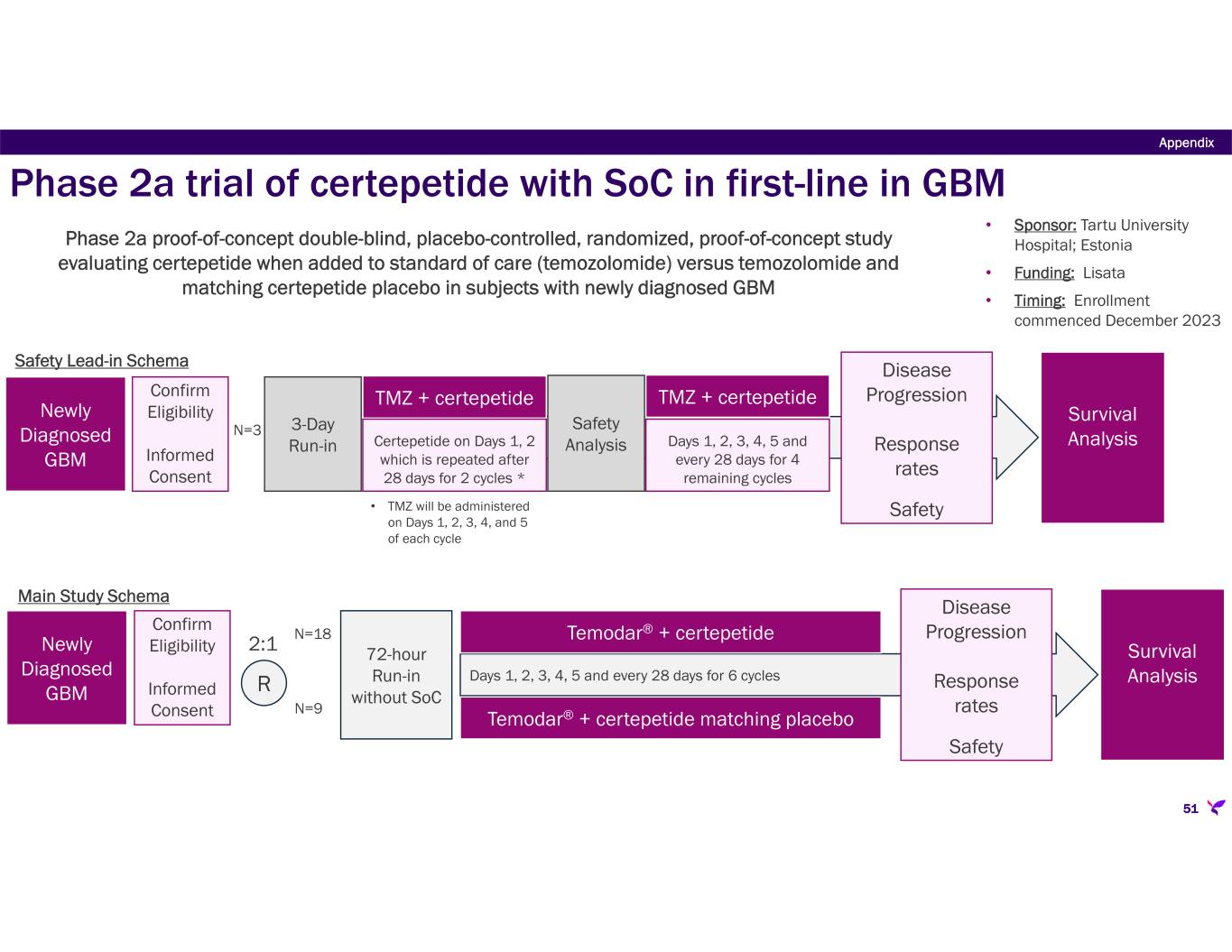
Days 1, 2, 3, 4, 5 and every 28 days for 6 cycles Disease Progression Response rates Safety Temodar® + certepetideConfirm Eligibility Informed Consent 2:1 Survival Analysis 72-hour Run-in without SoC Newly Diagnosed GBM R Temodar® + certepetide matching placebo N=18 N=9 Phase 2a proof-of-concept double-blind, placebo-controlled, randomized, proof-of-concept study evaluating certepetide when added to standard of care (temozolomide) versus temozolomide and matching certepetide placebo in subjects with newly diagnosed GBM • Sponsor: Tartu University Hospital; Estonia • Funding: Lisata • Timing: Enrollment commenced December 2023 Appendix 51 Phase 2a trial of certepetide with SoC in first-line in GBM Main Study Schema Safety Lead-in Schema Confirm Eligibility Informed Consent Newly Diagnosed GBM 3-Day Run-in N=3 TMZ + certepetide Safety AnalysisCertepetide on Days 1, 2 which is repeated after 28 days for 2 cycles * TMZ + certepetide Days 1, 2, 3, 4, 5 and every 28 days for 4 remaining cycles • TMZ will be administered on Days 1, 2, 3, 4, and 5 of each cycle Disease Progression Response rates Safety Survival Analysis

Lisata (U.S. only)Sponsor/Partner Evaluate the safety, tolerability, pharmacodynamics, pharmacokinetics, and efficacy of certepetide when given as a 4-hour continuous infusion in combination with SoC in subjects with second-line mPDAC who have progressed on FOLFIRINOX. Haystack Oncology MRD technology to measure ctDNA for early efficacy exploration. Objective Phase 1b/2a, double-blind, placebo-controlled, three-arm, randomized study evaluating the following treatment arms in subjects with second-line mPDAC who have progressed on FOLFIRINOX: an intravenous push of certepetide with continuous 4-hour infusion + SoC a single intravenous push of certepetide with continuous infusion of matching placebo + SoC an intravenous push of matching placebo with a continuous infusion of matching placebo + SoC Design N=30Study Size Safety and tolerability PFS, OS Endpoints First patient treated target 4Q24Timing Appendix 52 FORTIFIDE: Phase 1b/2a continuous infusion study of certepetide

FORTIFIDE: Phase 1b/2a continuous infusion study of certepetide Subjects with 2L mPDAC Obtain Informed Consent Confirm Eligibility Gemcitabine, certepetide 3.2 mg/kg single IV push/ 4-hour continuous placebo infusion + nab-paclitaxel Days 1, 8, and 15 every 28 days Gemcitabine, certepetide placebo single IV push/ 4-hour continuous placebo infusion + nab-paclitaxel Days 1, 8, and 15 every 28 days N=10 N=10 Gemcitabine, certepetide 3.2 mg/kg single IV push/4-hour continuous certepetide infusion + nab-paclitaxel Days 1, 8, and 15 every 28 days N=10 R Safety Biomarkers PK Disease Progression Response rates PFS OS Primary Endpoint: • Safety Secondary Efficacy Endpoints: • Mean change from baseline in CA19-9 and CEA • Mean change from baseline in ctDNA (quantitative) • Pharmacokinetics of certepetide • ORR, PFS, OS Secondary Efficacy Endpoints to be assessed: • At baseline • C1 Day 1 (2 and 4 hours after dosing) • C1 Days 8, and 15 pre-dosing for Cycle 1 • Day 1 of each subsequent cycle until disease progression 72 hour Run-in without SoC 72 hour Run-in without SoC 72 hour Run-in without SoC 53




















































